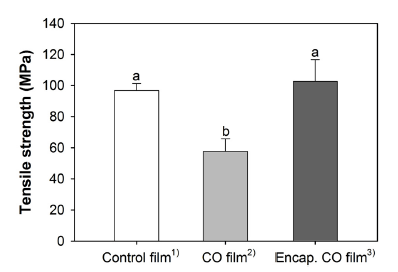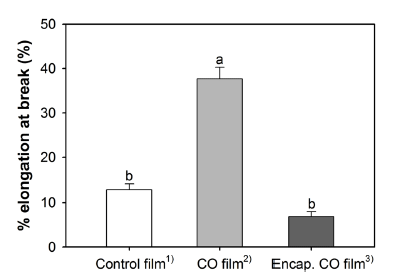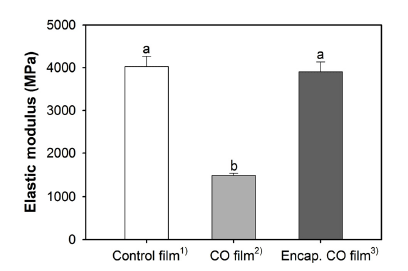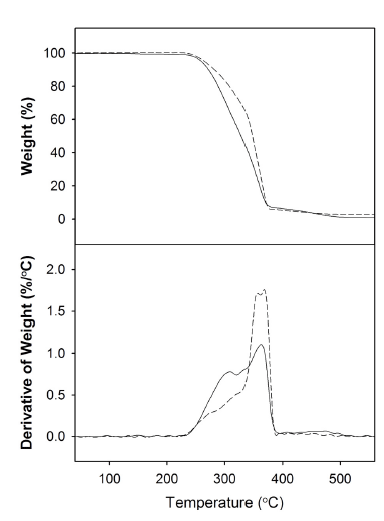Article
파일럿 규모의 필름 생산 시스템을 이용한 계피 오일 미세캡슐로 코팅된 폴리프로필렌 필름의 개발
오윤아, 송아영, 민세철*
Development of Microencapsulated Cinnamon Oil-coated Polypropylene Film Using a Pilot-plant Scale Film Coating System
Yoon Ah Oh, Ah Young Song, Sea C. Min*
Department of Food Science and Technology, Seoul Women's University
*Corresponding Author : Sea Cheol Min, Department of Food Science and Technology, Seoul Women's University, 623 Hwarangno, Nowongu, Seoul, 139-774, Korea Tel: +82-2-970-5635; Fax: +82-2-970-5977
smin@swu.ac.kr
© Korean Society for Food Engineering All rights reserved. This is an Open-Access article distributed under the terms of the Creative Commons Attribution Non-Commercial License (http://creativecommons.org/licenses/by-nc/3.0/) which permits unrestricted non-commercial use, distribution, and reproduction in any medium, provided the original work is properly cited.
Received: Oct 11, 2014; Revised: Nov 10, 2014; Accepted: Nov 11, 2014
Abstract
A microencapsulated cinnamon oil (CO)-coated film was developed using a pilot-plant scale film coating system. CO microencapsulated with polyvinyl alcohol was incorporated with a printing ink and the ink mixture was applied to the surface of a polypropylene (PP) film as an ink coating using a gravure printing press at a speed of 20-200 m/min. The tensile strength, percentage elongation at break, elastic modulus, and water vapor permeability of the PP films with and without coating with the microcapsules were not significantly different (p > 0.05), which indicates that the coating did not alter those properties of the films. Microencapsulation effectively prevented the volatilization of CO in the films. The microencapsulated system may be extended to other food-packaging films for which the same ink-printing platform is used. The results from this study imply that the oil-microencapsulated films could be potentially produced by a modern film manufacturing system.
Keywords: cinnamon oil; microencapsulation; pilot-plant scale coating
서 론
해충의 식품 포장재 침입은 직접적으로 제품을 손상시킬 뿐만 아니라 식품을 보존하기 위한 추가비용을 발생시켜 경제적 손실을 불러일으킨다(Hanlon et al., 1998). 식품 포 장재는 해충의 침입으로부터 식품을 보호하는 최종방어선 이지만, 제조과정에서 제대로 밀봉되지 않거나 완벽하게 밀봉되더라도 해충에 의해 구멍이 생길 수 있기 때문에, 제품의 이송 또는 저장 중에 해충이 유입될 수 있다 (Mullen, 1997; Hou et al., 2004; Licciardello et al., 2010). 식품의약품안전처(MFDS, 2014)에서는 최근 3년간 식품 이물질 중 가장 많은 신고가 접수된 것이 해충(37.9%)이라 고 보고하였다. 이러한 해충의 침입을 막기 위해 디에틸톨 루아미드(diethyl toluamide, DEET), 포스핀, 메틸브로마이 드 등의 합성 방충제가 많이 사용되고 있으나(Katz et al., 2008; Chu et al., 2011), DEET는 동물의 생식과 발달에 악영향을 미치며, 독성반응을 나타내고, 플라스틱과 합성 수지에 손상을 입히는 문제점이 있고(Wright et al., 1992; Gillij et al., 2008), 포스핀과 메틸브로마이드는 오존층 파 괴 물질(ozone-depleting compounds)로 밝혀져, 이들을 대 체할 안전하고 효과적인 방충제들을 찾고 있다(Chu et al., 2011).
식물 추출 에센셜 오일은 천연 해충 제어 물질로서 합성 방충 물질보다 빠르게 생분해되면서 살유충 및 방충 효과 를 보여 합성 방충제의 대체제로 주목 받고 있다(Landolt et al., 1999; Chu et al., 2011). 시트로넬라(citronella) 오일 은 거짓쌀도둑거저리, 팥바구미에 대하여(Wong et al., 2005; Ratnasekera & Rajapakse, 2009), 님(neem) 오일은 모 기, 팥바구미에 대하여(Sharma, 1993; Ratnasekera & Rajapakse, 2009), 계피 오일(cinnamon oil, CO)은 거짓쌀도 둑거저리, 어리쌀 바구미, 팥바구미, 화랑곡나방 유충에 대 하여 방충 및 독성 효과를 보였다(Huang & Ho, 1998; Ratnasekera & Rajapakse, 2009; Jo et al., 2013). 그러나 에 센셜 오일이 해충 방제 역할이 필요한 시기 이전에 휘발되 거나 산화될 수 있는 문제점을 지니고 있어 방충 물질로서 식품 포장재에 적용되는데 어려움이 있다(Moretti et al., 2002). 특히 포장재 생산 과정에서 발생될 수 있는 고온에 노출될 때 에센셜 오일의 휘발과 지방산화 문제는 더욱 커 질 수 있다(Kim et al., 2014).
미세캡슐화 기술은 주변 환경으로부터 에센셜 오일의 휘 발성을 감소시키고 안정성을 향상시킬 수 있다고 알려져 있 어(Soottitantawat et al., 2005), 방충 식품 포장재 개발에 이 용되어 왔다. Maji et al.(2007)은 방충 물질로 Zanthoxylum limonella 오일을 사용하고 벽 물질로 젤라틴을 사용하여 모 기의 접근을 막는 미세캡슐을 제작하였고, Kim et al. (2013)은 방충 물질로 CO를 사용하고 벽 물질로 폴리비닐 알코올(Polyvinyl alcohol, PVA)을 사용하여 화랑곡나방 유 충의 접근을 막는 미세캡슐을 제작하였다. 미세캡슐화를 통해 방출 속도가 늦춰진 CO가 저밀도폴리에틸렌(low density polyethylene, LDPE) 필름 표면에 잉크와 함께 코 팅되어 화랑곡나방 유충의 접근으로부터 모델 식품(쿠키) 를 효과적으로 보호하는 방충 필름이 개발된 바 있다(Kim et al., 2013).
Kim et al.(2014)은 미세캡슐화 된 CO를 폴리프로필렌 (polypropylene, PP)-LDPE 라미네이트 필름 표면에 잉크와 함께 코팅하여 쿠키, 밀크 초콜렛, 캬라멜 제품에 대한 화 랑곡나방 유충의 침입을 억제하였다. 미세캡슐화는 필름 내 계피알데하이드의 방출 속도를 낮추고, CO의 열적 안 정성을 증가시켰다. 미세캡슐화 된 CO가 혼입된 잉크는 LDPE와 PP-LDPE 라미네이트 필름의 인장 특성과 수분 차단 특성에 영향을 주지 않아, 기존의 포장 시스템에 개 발된 필름들이 대체되기에 문제가 없을 것으로 기대되었다 (Kim et al., 2013; Kim et al., 2014). 뿐만 아니라 개발된 필름은 미세캡슐화로 인해 CO의 열적 안정성이 향상되어 고온에서 행해지는 산업적 필름 생산 라인에서도 제작이 가능함을 보여주었다.
개발된 필름의 상업적 적용 가능성 검증을 위해서는 대 량 생산 기술 개발이 필요하고, 이를 위해서는 실험실 규 모에서 증명된 결과를 바탕으로 파일럿 규모의 생산 장비 를 이용한 연구를 수행하여야 할 것이다. 따라서 본 연구 의 목적은 (1) 파일럿 규모의 필름 생산 시스템을 이용하여 잉크 내 CO가 혼입된 PP 필름을 생산하고, (2) 개발된 소 재의 물리적 특성(인장 특성, 수분차단 특성)을 측정하고, (3) 미세캡슐화에 따른 필름 내 CO의 열적 안정성을 측정 하여 미세캡슐화의 필요성을 결정함으로써, 최종적으로 개 발된 필름의 상업적 적용 가능성을 확인하는 것이었다.
재료 및 방법
재료
CO(순도 100%)는 Scentipia (Bucheon, Korea)에서 구입 하였다. 벽 물질로는 PVA(Sigma-Aldrich Co., Ltd., St. Louis, MO, USA)를 사용하였으며, 유화제로는 Tween-80 (Ilshinwells Co., Ltd., Seoul, Korea)을 사용하였다. PP 필 름(두께 25 μm)은 Aumart(Bucheon, Korea)에서 제공받았 으며, 잉크는 대한잉크(주)(Anyang, Korea)에서 구입하였다. 잉크는 메틸에틸케톤(30-50%), 톨루엔(11-21%), 아세트산 에틸(10-15%), 우레탄수지(8-12%), 청색유기안료(8-12%), 프로필렌글리콜모노메틸에테르아세트산(6-11%), 아이소프 로필알코올(3-5%), 비닐 수지(3-5%), 폴리에틸렌 왁스(< 1%)로 이루어져 있었다.
CO 미세캡슐 에멀젼 제조
CO 미세캡슐 에멀젼은 Kim et al.(2013)의 방법에 따라 제조되었다. PVA 2 g을 증류수 98 g에 넣어 2시간 동안 교반하여 녹인 후, CO 5.5 g을 PVA 수용액에 첨가하여 3,000 rpm에서 5분 동안 균질기(Ultra-Turrax T-25D, IKA Labortechnik, Staufen, Germany)를 이용하여 균질화하였다. 균질화된 수용액에 Tween-80 0.07 g을 넣어 vortexing하여 CO 미세캡슐 에멀젼을 제조하였다.
파일럿 규모의 잉크 내 CO가 혼입된 PP 필름 제조
잉크 혼합물 내 CO의 농도가 2%(w/w)가 되도록 잉크에 CO 또는 CO 미세캡슐 에멀젼을 혼입하였다. 필름 인쇄에 사용된 잉크 혼합물의 조성은 Table 1에 나타내었다. 파일 럿 규모의 그라비아 인쇄기(Roto Gravure Printing Press, Ilsung Machinary Co., Ltd., Gumi, Korea)를 사용하여 상 온에서 20-200 m/min의 속도로 잉크 혼합물을 PP 필름 위 에 인쇄하였다. 잉크에 CO를 혼합하지 않고 시너(thinner) 만을 넣어 제작한 필름, 잉크에 시너와 함께 미세캡슐화 되 지 않은 CO를 혼합하여 제작한 필름, 잉크에 시너와 함께 CO 미세캡슐 에멀젼을 혼합하여 제작한 필름을 각각 ‘대조 구 필름’, ‘비 미세캡슐 CO 혼합 필름’, ‘미세캡슐 CO 혼합 필름’이라고 명명하였다. 각 필름들을 62-63℃ 저장고에서 72시간 동안 건조한 후 실험에 사용하였다.
Table 1.
Formulations of the ink mixtures coated on the polypropylene film to produce the film samples.
|
Film sample |
Formulation of ink mixtures |
|
|
Control film1) |
Ink 10 kg + thinner 4.2 kg |
|
CO film2) |
Ink 9.8 kg + thinner 4.2 kg + cinnamon oil 0.2 kg |
|
Encap. CO film3) |
Ink 9.8 kg + thinner 4.2 kg + cinnamon oil microcapsule emulsion 4.2 kg |
Download Excel Table
인장 특성
필름의 인장 특성은 미국 재료 시험 협회(American Society of Testing and Materials, ASTM) 표준 방법 D882- 01(ASTM, 1997)을 따라 측정하였다. 50×8mm 크기로 절 단한 필름 시료들을 온도 23±2℃, 상대습도 50±2%로 평 형화된 상대습도 챔버에 48시간 동안 저장한 후, 인장시험 기(WL2100, Withlab Co., Ltd., Anyang, Korea)를 사용하여 필름의 인장 강도(tensile strength, TS), 신장률(percentage elongation at break, %E), 모듈러스(elastic modulus, EM)을 측정하였다. 그립(grip) 간의 거리는 50 mm였으며, cross head speed는 30 mm/min이었다.
수분 차단 특성
필름의 수분 차단 특성은 ASTM E96-92를 변형한 Gravimetric Modified Cup 방법(McHugh et al., 1993)을 이 용하여 수증기 투과도(water vapor permeability, WVP)을 측 정하였다. 폴리메타크릴산메칠로 만들어진 원형 투습컵에 증류수 6 mL를 넣은 후, 투습컵 위에 지름 5.1 cm의 필름 시료를 올려놓고, 링 모양의 덮개로 덮어 나사로 고정시켰 다. 실리카겔을 이용하여 항습상자 내 상대습도를 3-8%로 평형화하였고, 항습상자 내 팬의 속도를 152 cm/min로 유 지하였다. 항습상자 내에 투습컵을 보관하면서 일정 시간 간격으로 무게를 측정하여 필름의 투습율을 구하였다. 투 습율에 필름 시료의 두께를 곱하고, 이것을 필름 양면의 부분수증기압 차이로 나누어 수증기 투과도를 산출하였다 (McHugh et al., 1993).
열적 안정성
CO 미세 캡슐의 열적 안정성은 열 중량 분석기(TA-50, Shimadzu, Kyoto, Japan)를 이용하여 분석하였다. 비 미세캡슐 CO 혼합 필름 또는 미세캡슐 CO 혼합 필름 시료 8mg을 알 루미늄 도가니에 담아 상온에서 600℃까지 10℃/min의 속도 로 가열하여 시료의 휘발에 따른 중량 변화를 측정하였다.
통계분석
필름의 물리적 특성은 2회 반복 측정하여 평균과 표준 편차를 산출하여 표시하였다. 시료 간의 유의차는 PASW Statistics 18(Ver. 18.0.0, IBM, NY, USA)을 이용하여 일원 배치 분산분석(one way ANOVA) 후 Duncan의 다중범위 검정(Duncan’s multiple range test)으로 검증하였다.
결과 및 고찰
인장 특성
대조구 필름, 비 미세캡슐 CO 혼합 필름, 미세캡슐 CO 혼합 필름의 인장 특성에 대한 결과를 Fig. 1-3에 나타내 었다. 대조구 필름의 TS는 96.9±4.5MPa, %E는 12.9±1.3%, EM은 4026.4±237.3MPa이었다. 비 미세캡슐 CO 혼합 필름 은 대조구 필름에 비하여 TS와 EM이 유의적으로 감소되 어 57.7±8.0MPa, 1500.6±50.1 MPa로 측정되었고, %E은 유의적으로 증가되어 37.7±2.6%로 측정되었다(p<0.05). TS, EM의 감소와 %E의 증가는 필름 유연성의 증가를 의 미한다(Hendrix et al., 2012). 필름에 첨가된 지방 성분은 고분자 네트워크 결합을 절단시켜 불균일한 필름 구조를 유도하고, 필름 매트릭스 내 자유 공간(free volume)을 증 가시켜 필름의 유연성을 증가시킨다(Fabra et al., 2008). 잉크 내 소수성 성분인 CO가 PP 필름과 결합하여 필름의 고분자 네트워크 결합을 절단함으로써 필름의 유연성을 증 가시킨 것으로 사료되었다. 그러나 미세캡슐 CO 혼합 필 름의 모든 인장 특성은 대조구 필름과 유의적인 차이를 나 타내지 않았다(p>0.05). 미세캡슐의 벽 물질인 PVA에 의해 CO와 필름 매트릭스 간의 직접적인 상호작용이 이루어지 지 않아 필름의 인장 특성이 CO의 영향을 받지 않은 것 으로 사료되었다. 이것은 인장 특성 관점에서 기존의 포장 시스템에 일반적으로 사용되고 있는 PP 필름을 대체하여 본 연구에서 생산된 미세캡슐 CO 혼합 필름이 사용 가능 함을 의미한다.2
Fig. 1.
Tensile strength of the polypropylene films coated with ink with and without cinnamon oil (CO) which was either encapsulated or unencapsulated. The coated film was produced by a pilot-plant scale-film manufacturing system.
1)Film coated with ink containing thinner
2)Film coated with ink containing thinner and CO
3)Film coated with ink containing thinner and encapsulated CO
Download Original Figure
Fig. 2.
Percentage (%) elongation at break of the polypropylene films coated with ink with and without cinnamon oil (CO) which was either encapsulated or unencapsulated. The coated film was produced by a pilot-plant scale-film manufacturing system.
1)Film coated with ink containing thinner
2)Film coated with ink containing thinner and CO
3)Film coated with ink containing thinner and encapsulated CO
Download Original Figure
수분 차단 특성
대조구 필름, 비 미세캡슐 CO 혼합 필름, 미세캡슐 CO 혼합 필름의 수분 투과율은 모두 0.007-0.016 g·mm/kPa·h·m2 로, 시료 간의 수분 차단 특성에 유의적인 차이가 나타나지 않았다(p>0.05). 플라스틱 필름 표면을 오일이 혼합된 잉크 로 코팅하여도 수분 차단 특성에 유의적인 차이가 나타나 지 않는 것은 Kim et al.(2013)과 Kim et al.(2014)의 연구 에서도 관찰되었는데, 이것은 플라스틱 필름 표면에 코팅 된 오일이나 잉크가 필름의 물 분자 이동 경로 및 매트릭 스에는 영향을 주지 않았기 때문으로 사료되었다. 미세캡 슐화 된 CO가 혼합된 잉크가 PP 필름의 인장 특성과 수 분 차단 특성에 영향을 주지 않음으로써, 기존의 PP 필름 을 이용한 식품 포장 시스템에 본 연구를 통해 생산된 필 름을 적용하여도 수분 차단 특성과 관련된 문제를 일으키 지 않을 것으로 예상되었다.3
Fig. 3.
Elastic modulus of the polypropylene films coated with ink with and without cinnamon oil (CO) which was either encapsulated or unencapsulated. The coated film was produced by a pilot-plant scale-film manufacturing system.
1)Film coated with ink containing thinner
2)Film coated with ink containing thinner and CO
3)Film coated with ink containing thinner and encapsulated CO
Download Original Figure
열적 안정성
비 미세캡슐 CO 혼합 필름과 미세캡슐 CO 혼합 필름의 열 중량 분석에 대한 결과를 Fig. 4에 나타내었다. 끓는점 이 194-234℃(Chemblink, 2014)인 CO는 두 필름에서 모 두 220℃부터 중량이 감소되기 시작하였으며, 두 필름 모 두 390℃에 중량 감소가 종료되었다. CO의 중량 감소가 일어나는 초반인 220℃부터 340℃까지, 비 미세캡슐 CO 혼합 필름에 비하여 미세캡슐 CO 혼합 필름의 중량 감소 속도가 느린 것으로 나타나, 미세캡슐화가 CO의 열적 안 정성을 향상시킨 것을 알 수 있었다. 방충 물질로서 에센 셜 오일이 혼입된 방충 필름이 상업적 규모로 고온에서 제 작되고 잉크 코팅에 의해서 인쇄될 때, 미세캡슐화 기술을 통해 오일의 열적 안정성을 확보할 수 있을 것으로 사료되 었다. Kim et al.(2014)은 미세캡슐화 기술을 이용하여 PPLDPE 라미네이트 필름에 적용된 CO의 열적 안정성을 증 가시킴으로써 410℃에서의 중량 감소율을 4배 이상 감소 시켰으며, 필름 내 계피알데하이드의 방출 속도를 감소시 킴으로써 쿠키, 밀크 초콜렛, 캬라멜 제품에 대한 화랑곡나 방 유충의 침입 억제 기간 또한 향상시켰다. 방충 물질의 미세캡슐화 기술이 상업적 규모의 필름 생산 과정에서 발 생되는 고온에도 방충 포장 필름의 방충 능력을 유지시킬 수 있는 기술로서 적용될 수 있음을 본 연구를 통해 확인 할 수 있었다.
Fig. 4.
Thermogravimetric analysis of the polypropylene films coated with ink incorporating cinnamon oil (CO) with or without microencapsulation produced by a pilot-plant scalefilm production system. Film coated with ink containing thinner and CO; Film coated with ink containing thinner and encapsulated CO.
Download Original Figure
요 약
본 연구에서는 파일럿 규모의 필름 생산 시스템을 이용 하여 잉크 내 CO가 혼입된 PP 필름을 생산하였다. 미세캡 슐화 되지 않은 CO는 PP 필름의 인장 특성에 영향을 주 어 TS와 EM을 감소시키고 %E을 증가시켰으나, 미세캡슐 화 된 CO는 PP 필름의 인장 특성과 수분 차단 특성에 영 향을 주지 않았다. 미세캡슐화 기술은 PP 필름에 대한 CO 의 영향으로부터 인장 특성을 유지시키면서 수분 차단 특 성에는 영향을 주지 않았고 CO의 열적 안정성을 향상시켰 다. 본 연구를 통해 파일럿 규모에서 생산된 오일 미세캡 슐로 코팅된 플라스틱 포장소재들은 방충 포장 필름과 같 은 기능성 필름으로서 상업적 식품 포장에 적용될 수 있을 것으로 기대된다.
감사의 글
이 논문은 2013학년도 서울여자대학교 자연과학연구소 교내학술연구비의 지원을 받았음.
REFERENCES
ASTM D822-01 Standard test method for tensile properties of thin plastic sheeting. 1997; American Society for Testing and Materials. Philadelphia, PA, USA: p. 162-170.

Chu SS, Hu JF, Liu ZL. Composition of essential oil of Chinese
Chenopodium ambrosioides and insecticidal activity against maize weevil,
Sitophilus zeamais. Pest Manag. Sci. 2011; 67:714-718.

Fabra MJ, Talens P, Chiralt A. Tensile properties and water vapor permeability of sodium caseinate films containing oleic acid-beeswax mixtures. J. Food Eng. 2008; 85:393-400.

Gillij YG, Gleiser RM, Zygadlo JA. Mosquito repellent activity of essential oils of aromatic plants growing in Argentina. Bioresour. Technol. 2008; 99:2507-2515.

Hanlon JF, Kelsey RJ, Forcinio H. Handbook of package engineering. 1998CRC Press, Technomic Publishing. Lancaster, PA, USA: .

Hendrix KM, Morra MJ, Lee HB, Min SC. Defatted mustard seed meal-based biopolymer film development. Food Hydrocolloids. 2012; 26:118-125.

Hou X, Fields P, Taylor W. The effect of repellents on penetration into packaging by stored-product insects. J. Stored Prod. Res. 2004; 40:47-54.

Huang Y, Ho SH. Toxicity and antifeedant activities of cinnamaldehyde against the grain storage insects,
Tribolium castaneum (Herbst) and
Sitophilus zeamais Motsch. J. Stored Prod. Res. 1998; 34:11-17.

Jo HJ, Park KM, Min SC, Na JH, Park KH, Han J. Development of an anti-insect sachet using a polyvinyl alcohol-cinnamon oil polymer strip against
Plodia interpunctella. J. Food Sci. 2013; 78:E1713-E1720.

Katz TM, Miller JH, Herbert AA. Insect repellents Historical perspectives and new developments. J. Am. Acad. Dermatol. 2008; 58:865-871.

Kim IH, Han J, Na JH, Chang PS, Chung MS, Park KH, Min SC. Insect-resistant food packaging film development using cinnamon oil and microencapsulation technologies. J. Food Sci. 2013; 78:E229-E237.

Kim IH, Song AY, Han J, Park KH, Min SC. Indian meal moth (
Plodia Interpunctella)-resistant food packaging film development using microencapsulated cinnamon oil. J. Food Sci. 2014; 79:E2023-E2030.

Landolt PJ, Hofstetter RW, Biddick LL. Plant essential oils as arrestants and repellents for neonate larvae of the codling moth (Lepidoptera Tortricidae). Environ. Entomol. 1999; 28:954-960.

Licciardello F, Cocuzza GE, Russo A, Muratore G. Quality maintenance performance and resistance to Tribolium castaneum and
Plodia interpunctella penetration of an alternative packaging material for semolina. Ital. J. Food Sci. 2010; 22:461-466.

Maji TK, Baruah I, Dube S, Hussain MR. Microencapsulation of
Zanthoxylum limonella oil (ZLO) in glutaraldehyde crosslinked gelatin for mosquito repellent application. Bioresour. Technol. 2007; 98:840-844.

McHugh TH, Avena-Bustillos R, Krochta JM. Hydrophilic edible films Modified procedure for water vapor permeability and explanation of thickness effects. J. Food Sci. 1993; 58:899-903.

Moretti MD, Sanna-Passino G, Demontis S, Bazzoni E. Essential oil formulations useful as a new tool for insect pest control. AAPS PharmSciTech. 2002; 3:64-74.

Mullen MA. Keeping bugs at bay. Feed Manage. 1997; 48:29-33.

Ratnasekera D, Rajapakse RHS. Repellent properties of plant oil vapours on pulse beetle (
Callasobruchus maculatus L) (Coleoptera Bruchidae) in stored green gram (Vigna radiate walp). Trop. Agr. Res. Ext. 2009; 12:13-16.

Sharma VP, Ansari MA, Razdan RK. Mosquito repellent action of neem (
Azadirachta indica) oil. J. Am. Mosq. Control Assoc. 1993; 9:359-360.

Soottitantawat A, Takayama K, Okamura K, Muranaka D, Yoshii H, Furuta T, Ohkawara M, Linko P. Microencapsulation of l-menthol by spray drying and its release characteristics. Innovative Food Sci. Emerg. Technol. 2005; 6:163-170.

Wong KK, Signal FA, Campion SH, Motion RL. Citronella as an insect repellent in food packaging. J. Agric. Food. Chem. 2005; 53:4633-4636.

Wright DW, Hardin BD, Goad PW, Chrislip DW. Reproductive and developmental toxicity of
N,N-diethyl-
m-toluamide in rats. Toxicol. Sci. 1992; 19:33-42.




